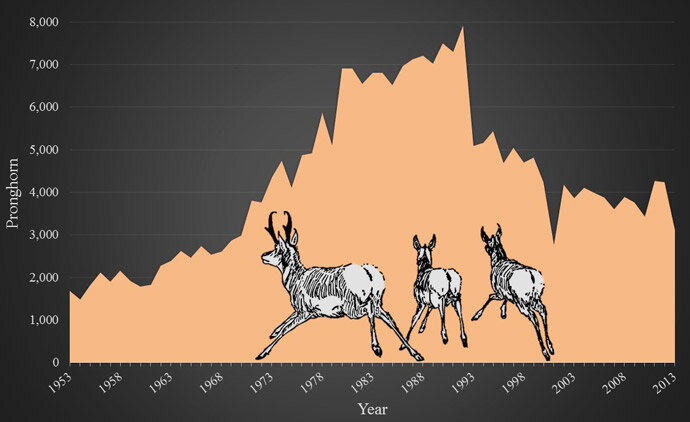Pronghorn
Antilocapra americana
History of Pronghorn in California
Pronghorn antelope are native to California and are an important species economically and culturally to citizens of the state. Their historic range included much of the Central Valley and southern and northeast areas of the state (yellow). Pronghorn prefer wide-open habitat including prairie and sagebrush plant communities, but over time this habitat has been depleted from agriculture, fire suppression, plant succession, invasive plants, and human development. Habitat loss has restricted the range of pronghorn to small, isolated populations in the Central Valley and northeastern corner of the state (brown).
Although pronghorn are a high profile and hunted species in California, little is known about their populations in the state, including specific causes of mortality and survival and reproduction rates. Research from other states has indicated pronghorn are especially susceptible to drought conditions, predation, and poor food availability. Additionally, pronghorn often migrate seasonally and require suitable habitat and minimal obstructions to their movement during migration. To keep populations healthy, wildlife biologists need to understand more about the factors that influence the range and abundance of pronghorn.
Population Trends
Pronghorn abundance in California once exceeded 500,000 animals, but habitat loss largely reduced this number over time. In 1942, the California Department of Fish and Wildlife (CDFW) began conducting winter surveys to count the number of pronghorn annually. From 1956–1970 the estimated population was between 1800-3000 animals and then increased through the early 1990’s. During a severe winter in 1992/1993 the population in the northeastern corner of the state decreased by almost half, and their abundance remains near that number today.
Population recovery has not occurred as expected, suggesting factors are limiting pronghorn survival and/or reproduction in that area. Increased land development projects and invasive plants threaten remaining pronghorn habitat throughout northeast California, which need to be considered for future viability of this population. Evaluating the survival and reproductive rates of pronghorn in relation to their habitat use and movements can therefore provide essential information for their conservation.
Research Objectives
The Institute for Wildlife Studies (IWS) and the California Department of Fish and Wildlife are working on a study which will collect information on survival and reproductive rates, as well as movements of pronghorn in northeastern California. Specific objectives for the study include identifying pronghorn:
1. Pregnancy rates
2. Survival rates of does and fawns
3. Physiological condition
4. Summer and winter ranges
5. Migratory behavior and location of migration routes and potential obstructions
6. Important seasonal habitat(s)
IWS staff will work closely with CDFW, private land owners, sportsmen, and other county, state and federal land agencies during this investigation in the hope of increasing our understanding of pronghorn biology and helping to ensure their populations remain healthy in northern California.
Pronghorn population by year.


